C&S #1006 Restoration Photos
123

















123
Re: C&S #1006 Restoration Photos
|
I want to let you know - as you restore this car; a friend and I were inside the car on Aug. 1, 2010 and to my amazement when I lifted the tool box/bench lid there was what I believe to be original C&S freight car red on the underside of the lid. It was a rich almost Tuscan color rather more violet that we had previously thought. Hope you can check this out and verify. No one had been inside the car for over ten year prior to that. Please let us know about this. Thanks.
|
|
Derrell,
Dale Buxton, who worked on the 1006 back in the day got a paint chip and took it to Caboose Hobbies, where he worked at the time, and compared it to all the Railroad colors. According to Dale, the closest color match in Model Railroad paint for the C&S Cabooses was Rock Island Maroon. Rick |
Re: C&S #1006 Restoration Photos
|
In reply to this post by C&S Railway Society
C&S Railway Society, two favors, please; first do you have a real name? and second please provide any evidence or proof 73 was built in 1881. This is contrary to the documented information I have and the "logic" I've been following. I would love to have this puzzled further clarified if not outright solved. I've offered my theories as fuel for furthering this question not as anything final. Hopefully we can help each other out.
|
Re: C&S #1006 Restoration Photos
|
In reply to this post by Rick Steele
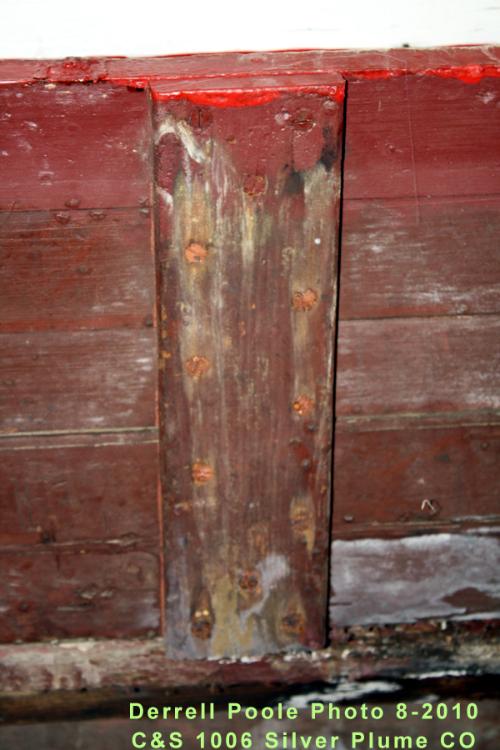 Yes I recall that formula and perhaps that is as close as we can get. I've compared it to Scale Coat colors and close is their Caboose Red. I'd like the rebuilders to check this out. |
Re: C&S #1006 Restoration Photos
|
You might be interested in some of the more recent posts on the NGDF regarding the C&S 1006 restoration.
|
Re: C&S #1006 Restoration Photos
|
In reply to this post by Derrell Poole
We found a similar color on the inside of the north facing wall. We've determined that the interior woodwork originates from the original construction. We came to that conclusion by observing the windows. Each window has a board above the window, presumably for accessing the interior window track. We found the same panels behind the cupola which correspond with the original windows which were removed in the early teens. This tells us that the interior walls have remained relatively unchanged since the caboose was constructed. In the photo you can see the red color on the interior wall, and the wa brace which was removed; presumably when the caboose's were rebuilt by the C&S into their current form.
 |
Re: C&S #1006 Restoration Photos
|
In reply to this post by Derrell Poole
Derrell,
My name is Benjamin Fearn, just to give you a picture I'm happy to give a brief bio on who we are; I worked for the D&SNG for 3 years in the Durango roundhouse, during my time there I was an apprentice boilermaker and I did a significant amount of the boiler work on the 315. Also I was a volunteer at the CRRM for one year during that time I worked on the 346, and spent a significant amount of time on the 491 restoration. Our organization is made up of 5 principle directors and a number of volunteers who have come forward to support us. the directors are Justin Kardas- President Benjamin Fearn -Vice President/ Treasurer Shane Schabow- Secretary Will Gant- director Matthew Brooks- director Justin Kardas, our President works in the Silver Plume shops and is an Engineman, on the GLRR. Justin spent one year at CRRM on the 491. Shane Schabow, has worked off and on at the GLRR since 2003 as a trainman and Engineman. Will Gant has been at the GLRR for four years and is a shopman, Engineman and trainman. Matthew Brooks has been at the Georgetown Loop for 2 years and is a Machinist and Engineman. Typically our policy is when we post is we speak for the organization. so we don't typically sign posts individually. Our organization was formed out of a desire to see an operating example of the C&S Railway come to be. We recognize that there are many fine examples of the D&RGW which are represented in Colorado, not only in complete tourist railroads but numerous historical groups. Being that the C&S was a narrow gauge railroad nearly as expansive as the D&RGW, there seems to be no real example of this railroad in our State. With so many narrow gauge railroads in the country such as the WP&Y, the EBT, the ET&WNC, all have some operational representation, however there is none for the C&S. We desire to rectify that in time. We have many consultants in the Tourist railroad business in Colorado who have shown support for our project and offered their experience. among those are Phil Johnson, Superintendant of the Georgetown Loop, Jeff Badger, Shop foreman of the Georgetown Loop, Sean Jackson, the Car shop foreman of the D&SNG, and Gregory Posta, founding President of the Ridgway Railroad museum. |
Re: C&S #1006 Restoration Photos
|
In reply to this post by Derrell Poole
Derrell,
The year on the caboose, We will get back to you on that, Shane Schabow has done the principle research on the early history of the caboose, and I need to contact him. We have had some conflicting information; for example early on we cited Mal Ferrell as saying the 1006 was Waycar 72; We were corrected on this, and informed it was 73. The discovery of the number 1511 certainly confirms it is the 73. As to the year of construction, I may have misquoted and It may be 1882 but I need to ask Shane about that. |
Re: C&S #1006 Restoration Photos
|
Benjamin,
Thanks for all the info. A friend and examined the caboose in 1910 and were very concerned that snow had apparently regularly gotten into the car at the cupola and the car was deteriorating. We tried to contact appropriate people of Silver Plume to encourage some action to be taken to preserve the car - if not restore it. I have mixed feelings about restoration because of the information that can go unrecognized and inadvertently destroyed with the replacement of parts. I trust your organization is very aware of this and will record what has been found and what has been done. In the end I hope to see this car put into a condition that will preserve it for a very long time. My thanks. As to the original number of 1006 unless more information comes up we will never be able to identify that with certainty. My information came from C&S Records; Folio No. 27, the C&S Journals, the 1899 Renumbering Schedule (thru 1907) and Erecting Drawings provided by George Lundberg thru the late John Maxwell, various rosters and entries in the Official Railway Equipment Registers. Information also came from the C&S, DL&G & UPD&G files (miscellaneous items). Finally information from the UP Boston Journals (1878 - 1899), UP Annual Reports, much correspondence with independent researchers such as John Maxwell and Ron Rudnick and their investigation into various organizations (museums and libraries) around the country. Sounds like a lot but in reality it isn't much. All can be summed up as follows (working backwards); in the spring of 1912, 308 became 1006 when cabooses and refrigerators were renumbered. A drawing dated 22 June 1908 began a modernization of the caboose structures (I believe but have no proof that many of the frames had already been rebuilt in 1903 to conform with United States Safety Appliances laws). This program took place over the next few years and it seems some cars were never upgraded - but again no proof of that. Car 1511 was renumbered and lettered to C&S 308 on 22 Sept. 1900. I have not found any additional details of what happened to the car prior to that point although there are some interesting details that can be generally applied to 1511 during the 1890s. The South Park had a total of 23 Waycars (perhaps more if the two cars that came from the Sante Fe in 1879 are counted separately). But by June 1885 when the UP renumbering occurred the roster included just 21 cars. One car is known to have vacated in Dec. 1883. The other most likely after April 1884. The equation between the 1885 Reno.g and the original set, 60 - 82, is that there were 23 numeral positions in the series. The two cars lost prior to June 1885 throw off a neat correlation between 60 series and 1500 series. But if we ignore this for a minute we can establish that 1511 equated to 71 in the 12th numeral position. We don't know which numeral positions were vacated by the missing cars. If one car below the middle position of the series - roughly no. 73 - then car 72 became 1511. The UP assigned numbers sequentially to then available cars. Cars higher than the missing number all moved down in position when renumbered; that would assign 1511 to car 72. If both missing cars were low numbers then 1511 would have applied to car 73. Since only 2 cars were vacated the possible numbers for 1511 were limited to 71, 72 and 73. This isn't all of the information. The Folio drawings indicate 308 (1006) was built in 1882. I have two versions of the caboose sheets. One is the typical set and the other is made up of tracings by John Maxwell of George Lundberg's set. In the tracing John has a build date of 1883 for caboose 309 (1007). This is potentially important because the two cars were therefore from separate lots over a calendar rotation. In the 1500 series 1511 and 1513 (1007's number) was also separated by a car that never bore a C&S number. What we don't know for fact are what cars were built in 1882. The UP Journal entry says "March 1882 Cabooses" for the amount of "$1114.57". Other entries define the cost of cabooses to range from 371.00 for these cars (three cars?) to as much as $565.00 for 79 in January of 1884. A single car might have cost more if shipping was included in the entry. The assumption, in absence of documentation, has been that this 1882 entry was for 3 cars. With the assumption that the Folio date is correct, and recognition of the position numerals, it is a pretty strong argument that the three cars were 71 - 73 (71 and 1511 in the 12th position). If that is the case there is no entry for 74 and 75 but the date on the Folio sheet for 1007 suggests those two cars would have been built in 1883. In Sept. 1883 76 -78 were built. This "information" might narrow the equation of 1511 to just two cars since 71 as 1511 would pull 1513 into the lot of 1882. Vacated numerals below 71 would only exacerbate this restriction. This is a bit confusing I'm sure. I began working on this string of thought over 20 years ago and still have most of my notes. It was the basis for the chart in the back of Robb Grandt Narrow Gauge Pictorial Vol. VIII. I'm looking forward to any additional information your historian might be able to share. |
Re: C&S #1006 Restoration Photos
|
Derrell,
Thank you for the information, this is greatly appreciated. We have found limited resources thus far; the CRRM Library did not have very much for us on the 1006, however we have not yet addressed the History Colorado archives, or the Denver Public Library. Also worthy of note, DRHS when doing research on the 315 found significant information in the archives of the California State RR Museum. When I worked with the DRHS on the 315, one thing I took note of was they were very thorough. And George Niederauer notes in his book, that it was a learning curve for them. In the beginning in their enthusiasm they were not as methodical about cataloguing parts as they came off the engine. as a result later he notes that they realized it would have been good if they had take more photographs as the engine came apart. Lessons learned, and I'm glad to have learned from their experience. Thankfully, technology has made it such that taking hundreds of digital photos is not an inconvenience or expense the same way as taking all those photos on film would have been. Naturally since the 1006 is so well preserved it is our paramount desire to save as much of the historic fabric of the Caboose as possible. you are quite correct in that the caboose suffered significant deterioration under the cupola. We've determined so far that the south facing side of the caboose was completely resided (we're told in the 1970's) also it appears the 'B' end(away from the cupola) was resided as well. So far we've found the frame to be in very good condition. The only place where we found significant deterioration was on the North side wall under the cupola, this was where the caboose got the least sunlight and so that area was the least prone to dry when saturated. During last summer we got inside the Caboose on an afternoon after a Very rainy day. This gave us the opportunity to see the water damage in its worst condition. We only found a leak in the roof itself in the center of the car, and the interior saturation was isolated to drippage from that area(excluding the cupola which was a whole thing of its own.)  |
Re: C&S #1006 Restoration Photos
|
Fascinating work and a noble endeavor.
Does you society accept supporting memberships or donations, so that many of us like minded C&S fans can help support your work? IMHO that beautiful piece of arched siding over the door, with the yellow paint and UP-DL&G number should be carefully removed and mounted in a display case, to later reside inside the caboose. It is my understanding that, although the Union Pacific established a systemwide renumbering system for the UP proper and its subsidaries in 1885, the UP did not proscribe a system standard for caboose painting and lettering until 1887. According to Randy Hess, those documents describe a body color of "chrome yellow" with brown or maroon lettering, underframe and roof. The color you have discovered on 1006 looks to me to be a bright yellow, muddied by overcoats of 120+ year old varnish, consistent with the 1887 UP standards. The question remains, was 1511-1006 painted another color when originally built? Others have speculated that the South Park cabooses built by the UP after 1881 may have been initially painted yellow but perhaps a different shade, as the UP and subsidaries had not yet established a firm paint scheme, proscribing a specific paint color. Color samples have been posted on the net from the restoration of C&S caboose 1008: https://plus.google.com/photos/108652524348276372534/albums/5654093981316116497?banner=pwa&authkey=CMG5u7PQv7OLpgE The yellow in those samples seems different to me, either a light buff or perhaps straw yellow. Any chance a small smidgen of that wonderful yellow siding on 1006 could be used for further examination as to any other paint layers underneath? Like other, older, perhaps different shades of yellow paint. This might further prove that the notion that these cars were originally white is a myth (unless of course your find white at the bottom!). Again, thanks for your great work and keep us posted with any new archeologic finds!
Jim Courtney
Poulsbo, WA |
Re: C&S #1006 Restoration Photos
|
In reply to this post by C&S Railway Society
In this view the bench lid on the left is where I found what I felt was the most preserved color of C&S freight Car Red. I am of the opinion that this would date from the 1908 plus rebuild.
|
Re: C&S #1006 Restoration Photos
|
In reply to this post by C&S Railway Society
Between the two of us we took hundreds of photos (I've never counted). If they can be of use to you and any preservation effort I'll burn them to a disk and send them to you (with Fred's permission).
These photos belong to me. 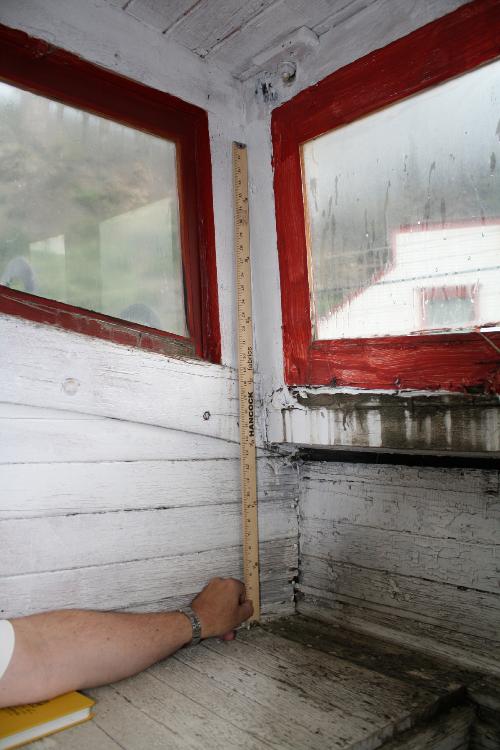 "A" end corner of Cupola 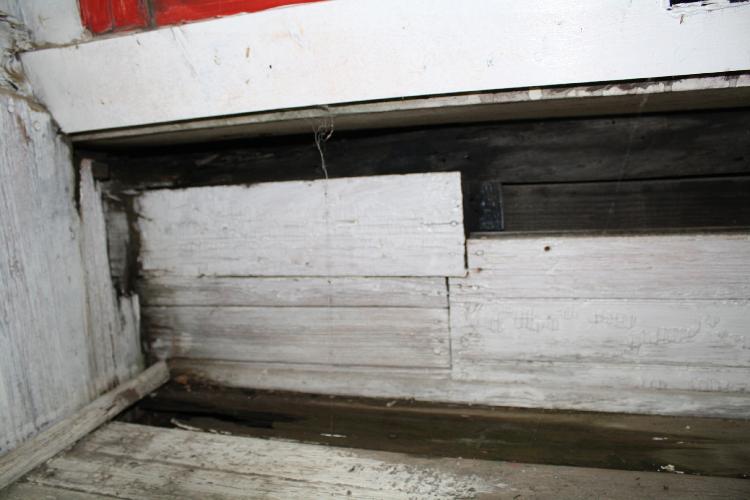 Water Damage below windows 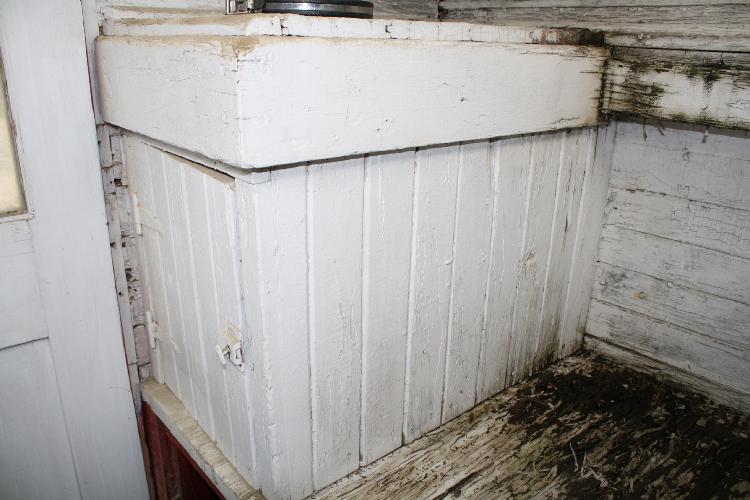 Damage below Cupola seats 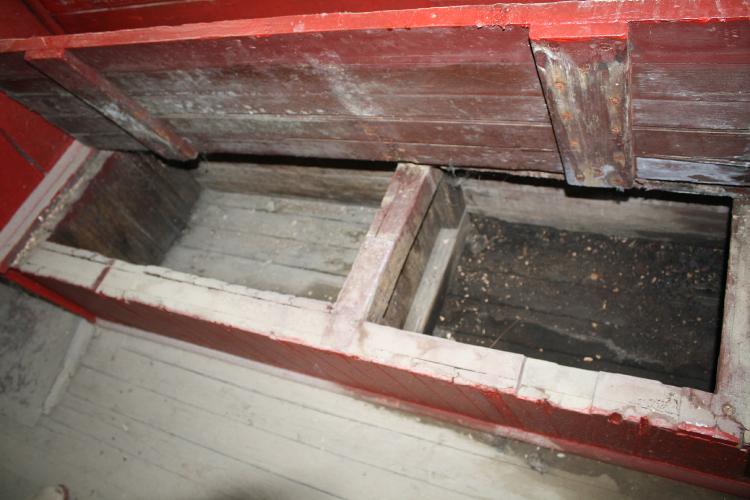 Lid on left with original red paint |
|
Administrator
|
In reply to this post by C&S Railway Society
Where is all this work on #1006 being done?
|
Re: C&S #1006 Restoration Photos
|
Mike,
The restoration work is being done in Silver Plume at the Georgetown Loop RR shops. Evidently, these gentlemen constructed 3' gauge track panels and slowly moved the caboose from it's location downtown, down the street, under the Interstate and to the GL RR shops!
Jim Courtney
Poulsbo, WA |
Re: C&S #1006 Restoration Photos
|
A video of the caboose being moved can be seen here:
https://www.youtube.com/watch?v=7g_C7VCj9hI
Jim Courtney
Poulsbo, WA |
Re: C&S #1006 Restoration Photos
|
I misspoke; the restoration work is being done at the old stone Silver Plume town shops building. Little 1006 has yet to cross the Intersate!
Jim Courtney
Poulsbo, WA |
|
In reply to this post by Derrell Poole
Could there be white or cream finish under the yellow as indicated with the green arrows? Looks like there was a thin trim or fascia that was in place between the vertical sheathing and the ceiling that the yellow did not cover over but hard to tell from a digital image.
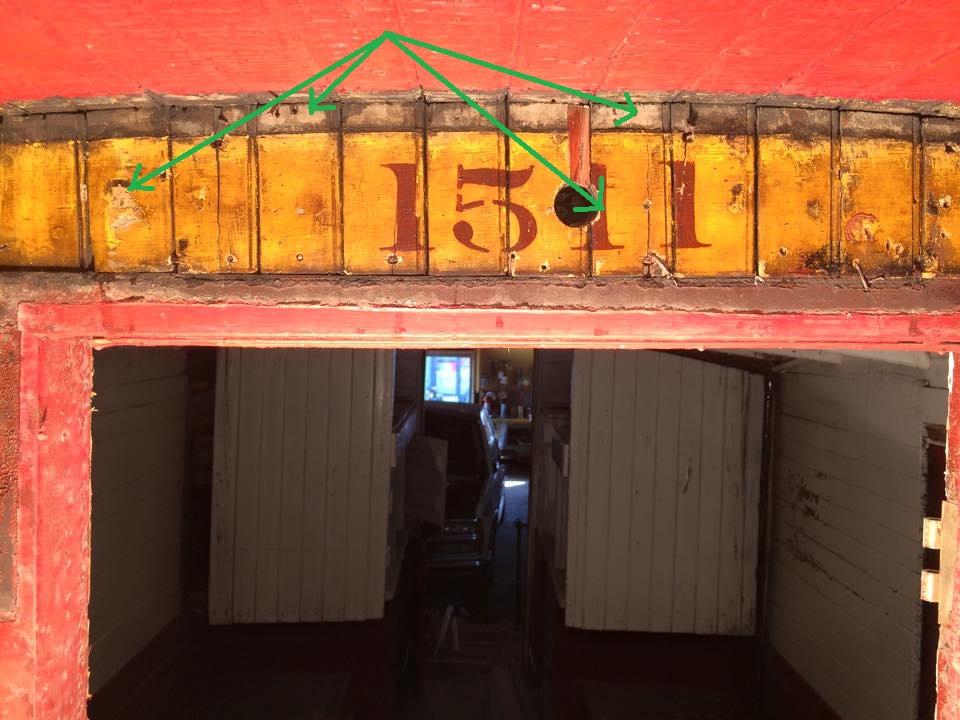
|
Re: C&S #1006 Restoration Photos
|
How would you account for fading and ageing of the paint,dirt and grime,and stains?
|
Re: C&S #1006 Restoration Photos
|
In reply to this post by Jeff Ramsey
Jeff,
Its within the realm of possibility, we are considering removing one of the pieces of the scribed siding and using it for paint analysis. but its entirely probable that what you are seeing is just faded yellow. what you are seeing on the top is just unpainted wood, that is where the original quarter round trim was placed. |
«
Return to C&Sng Discussion Forum
|
1 view|%1 views
| Free forum by Nabble | Edit this page |

